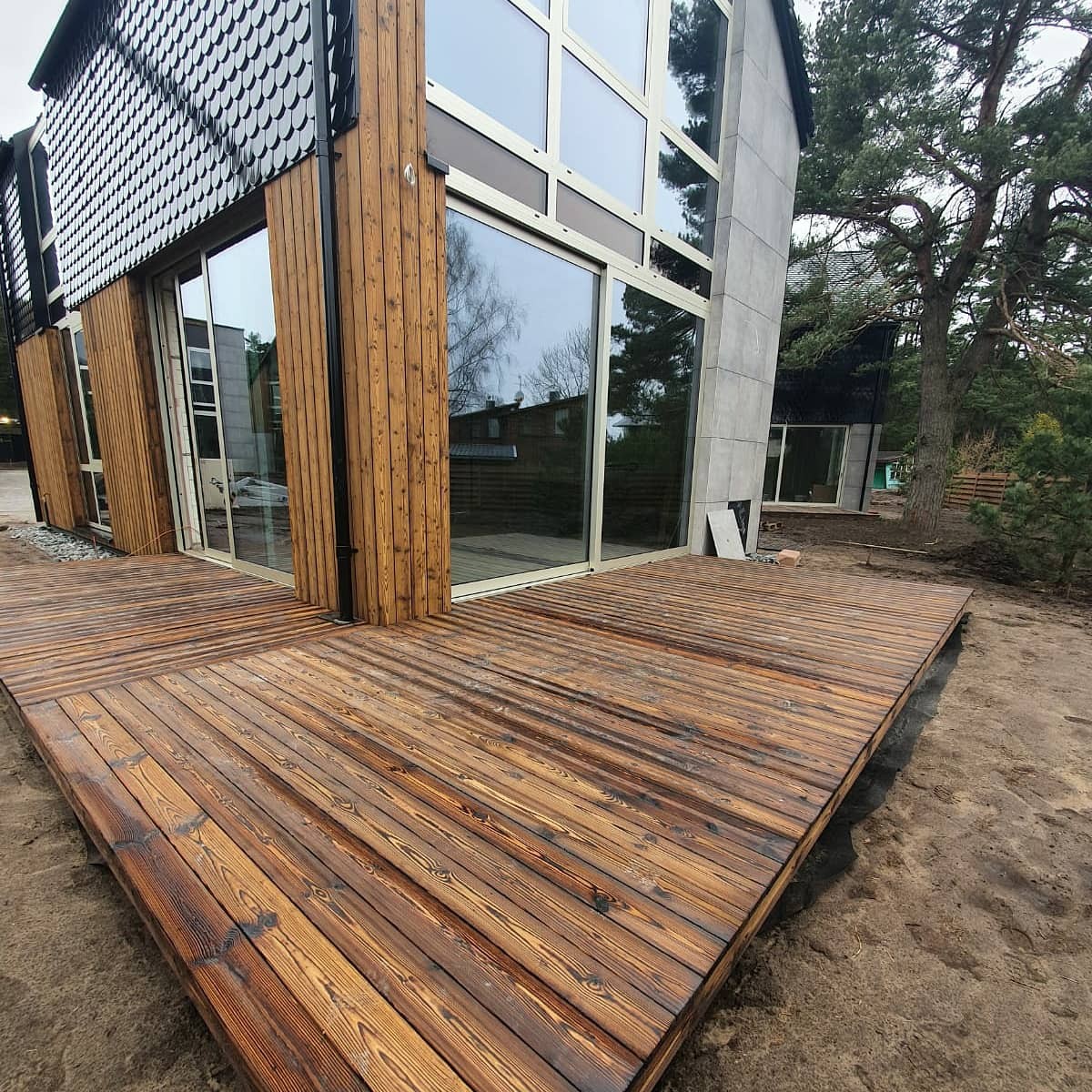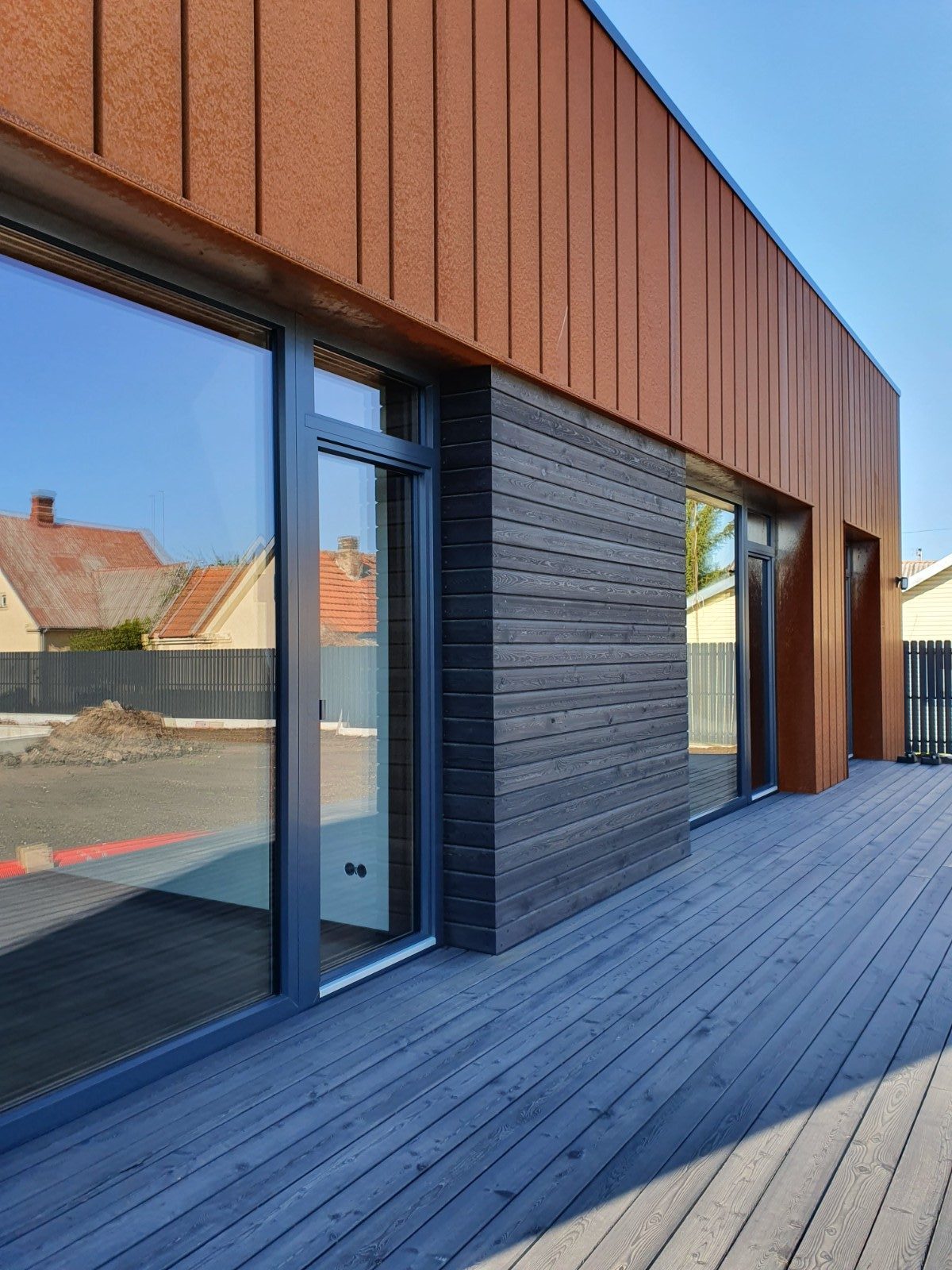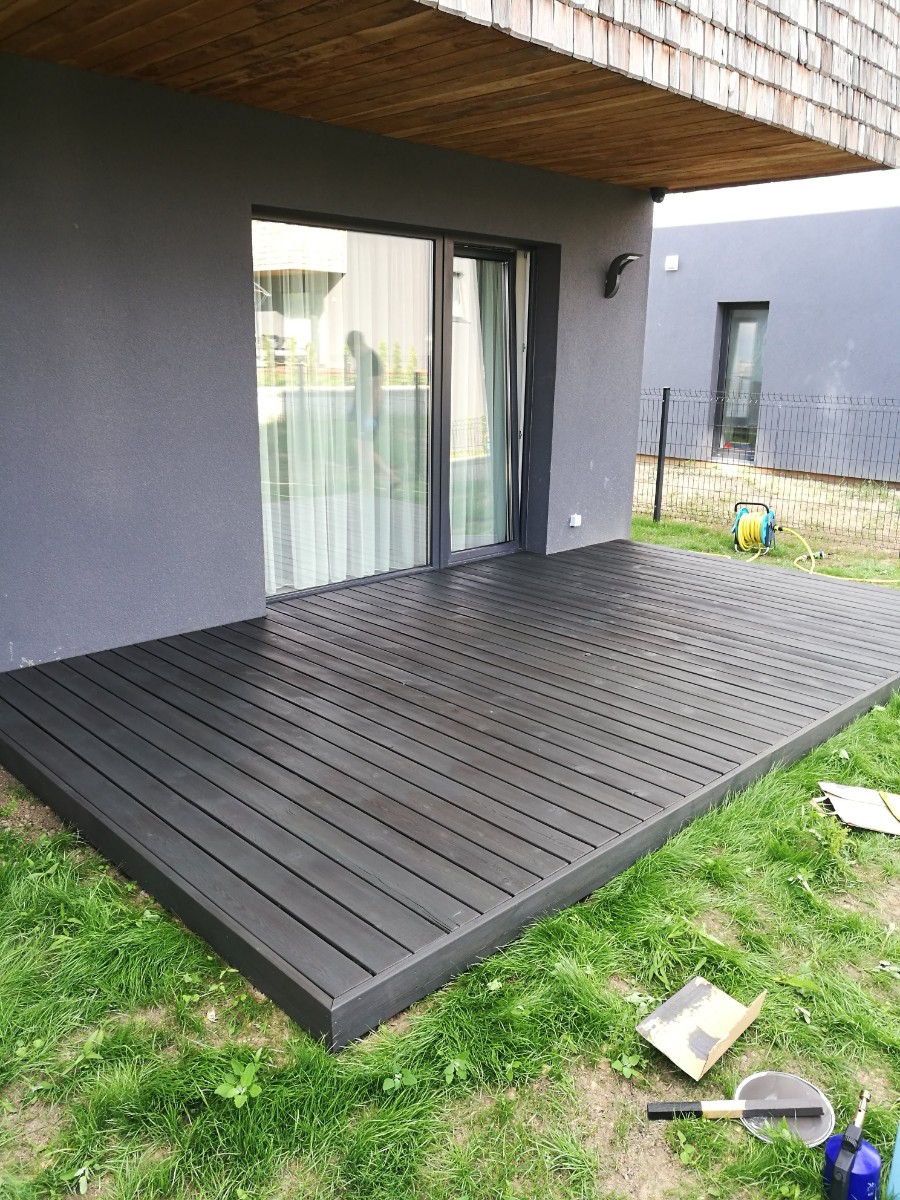Wood vs. Composite Decking: The Ultimate Comparison
A deck can be an outdoor living room, an oasis for solitude, or a way to integrate nature into your everyday life. Decks increase the living space, resale value, and aesthetic appeal of a home. Choosing the flooring material is one of the most important decisions while building a deck. Natural wood and wood composite are the two common options. Both alternatives differ in properties, aesthetics, textures, and costs. Below we compare timber vs. composite deck flooring for maintenance, durability, and cost.

Wood Deck – Pros and Cons
Constructed from beautiful timbers such as cedar, pine, larch, and spruce, wooden decking sports a rustic beauty perfect for the outdoors. However, as with any project, homeowners should always consider several factors before investing in a wooden deck. The most important are maintenance, durability, and cost
Maintenance
Natural wood decks need annual upkeep to stay beautiful and functional. This maintenance ritual helps a deck reach its full lifespan. Regular cleaning and upkeep also minimize the risk of structural and cosmetic damage. Wooden deck care comes with both advantages and disadvantages for homeowners to consider.
-
Pros
One of the main benefits of wooden deck maintenance is that most responsible homeowners naturally incorporate these tasks into their home care routine. For example, the deck floor needs to stay free from debris such as leaves and twigs. Uncleared piles can trap moisture and lead to rot or discoloration. Most homeowners do not want leaves or other debris cluttering their outdoor space, so they’ll keep their decks clear all the time regardless.
Decking flooring should also receive annual cleaning, and a light power washing should do the trick. Deck cleaning products are great for a deeper clean or removing discoloration. Maintenance is even easier for a deck constructed with Shou Sugi Ban. Also known as Yakisugi, burnt wood decking does not need any special cleaning solutions. An inexpensive vinegar and water mixture is perfect for a deep clean.
-
Cons
Applying stains and sealants is the main way to care for natural wood surfaces. Stains allow the homeowner to add color to the deck, while sealants protect the wood from the elements. New sealant technology allows a properly applied product to last three or more years. Sealant products do add to the cost of upkeep. The homeowner must apply the protective chemicals or pay a higher price for professional application.
However, when talking about Shou Sugi Ban, these drawbacks are almost non-existent. The wood-burning technique seals each board with a protective carbon layer of char. The charred wood is resistant to moisture, rot, discoloration, and pests, eliminating the need for annual stains and sealants.
Yakisugi burnt wood can be stained for color preference and allows the homeowner to choose a specified aesthetic. The timber requires only a thin coat of oil after charring. For greater durability and beauty throughout its lifespan, Shou Sugi Ban wood should receive an oil treatment every 10-15 years. A decade or more between treatments provides a sharp contrast to the more frequent sealant ritual for natural wood decking flooring.
Durability
Homeowners should also consider the lifespan of decking materials. The average natural wood deck should last about 20 years. A well-maintained natural wood structure can last 30 years or longer. Shou Sugi Ban charred wood products yield for 50 years of use, with the potential to endure a century or more. The actual outcome depends on two factors: proper installation and maintenance. Hinging on these two variables, homeowners should be aware of wooden decking durability’s pros and cons.

-
Pros
The good news for homeowners wanting a long-lasting wooden deck: anything is possible with the proper installation and care. Decking flooring should stay clean and dry and receive all the suitable treatments. If done well, the decking will repel water, resist fading from UV rays, and stay beautiful for years.
A wooden deck’s construction will also significantly impact its lifespan. A good builder will create a steady foundation and ensure the deck is securely attached to the house. Then, the structure should be well-equipped to withstand changing temperatures and weather throughout the year.
-
Cons
Deficient construction or missed maintenance will have a notable influence on a structure’s lifespan. For this reason, homeowners must choose a builder who is knowledgeable, honest, and committed to excellence. As for maintenance, the homeowner is in control. A well-cared-for wooden deck will last, while a neglected one is susceptible to fading color, pests, and rot.
Charred wood products help ease a homeowner’s maintenance burden. Shou Sugi Ban timber becomes resistant to those natural wood ailments of moisture, sun, pests, and rot through the wood-burning process. Charred wood also requires less frequent treatments, lessening the demand for the homeowners’ time and money.
Cost
Price is an essential consideration for any project. Homeowners want to invest in additions that will last and become talking points when listing a home for sale. Wooden decks bring both positive and negative financial impact.
-
Pros
Natural wood is one of the most affordable decking materials. Lumbers like bamboo, cedar, redwood, and pressure-treated pine are popular for that reason. Comparing pressure-treated wood vs. composite decking cost shows a sharp contrast. Pressure-treated lumber is one of the less pricey alternatives, while composite is among the most expensive. Even high-quality decking lumbers typically cost less than composite decking boards.
Keep in mind any deck will add value to a home. Because wooden decks have a lower upfront cost, the homeowner often receives a higher return on investment with increased property value.
-
Cons
Maintenance expenses represent the main financial drawback for natural wood decks. The average deck owner buys a cleaner solution, stains and sealants, and a power washer rental every few years. Those purchases add up, raising the total price of the homeowner’s investment.

Shou Sugi Ban products have a higher price range than untreated or pressure-treated wood. However, Yakisugi decking does not need the same level of costly maintenance that natural wood demands, thus saving money in the long run.
Composite Deck – Pros and Cons
This material is a blend of wood fibers and plastic compounds. The final product resembles the shape and size of natural wooden boards. It often has a wood grain pattern stamped onto the exterior to increase the resemblance.
Wood composite deck boards have become a popular alternative to natural wood decking flooring. The maintenance, durability, and total cost of this modern material differs from natural wood. Homeowners should consider these factors before utilizing this synthetic product.
Maintenance
As with any outdoor space, a wood composite deck requires maintenance to keep looking good for longer. This material brings a distinct set of bonus features and setbacks to the homeowners’ annual maintenance schedule.
-
Pros
One of the main selling points for wood composite deck boards is the minimal upkeeping this material requires. Once manufactured, most composite does not need sanding, staining, painting, or sealing. For “uncapped” composite, which does not have a plastic top coating, the homeowner can stain the deck surface if desired.
Regardless of staining preferences, the wood composite deck boards need regular cleaning. Routine scrubbing with water and a soft brush can keep this synthetic surface looking brand new. Homeowners should also deep clean the surface with a deck cleaner twice per year.
-
Cons
While the required maintenance is minimal, composite decking upkeep options can be constricting for hands-on homeowners. The surface on standard composite decks should not receive power washing. The powerful spray can disrupt the surface finish, which can sometimes void the deck’s warranty.
Composite decks also need special attention to avoid stains from fallen leaves and mold and mildew buildup. Except for PVC-coated varieties, wood composite is a porous material. Deck cleaning solutions can penetrate the decking boards. This way, it can better eradicate mold and mildew before these microorganisms can cause an issue. A strong deck cleaning product may help erase or lessen stains’ appearance on the composite surface.
Homeowners should be aware that composite material is not reparable like natural wood. While natural wood decking flooring can be power washed, sanded down, repaired, and restored, composite boards, cannot. If composite decking receives damage from vigorous power washing or inclement weather, the affected boards may need replacement.
Durability
The lifespan of composite wood also depends on proper installation and routine maintenance. In this category, composite boards bring both advantages and disadvantages to deck owners.

-
Pros
Since arriving on the home improvement market during the 1990s, composite decking has promised consumers longevity. Advertisements claim this material will not rot, warp, splinter, or become infested by bugs—some newer varieties of composite feature a PVC plastic coating for even more protection from the elements. Overall, wood composite deck boards can potentially last a very long time in ideal conditions.
-
Cons
Though wood composite materials receive extensive lab tests, please note this material is still new to the construction industry, especially when compared with natural and charred wood. When looking at real wood vs. composite decking, there are countless examples of actual wooden decks that have lasted decades and even centuries.
By contrast, composite decking has not been widely available long enough for such examples to show how the material actually behaves over such an extensive time. Though many builders that offer composite decking advertise the product will not fade, it is impossible to mitigate the sun’s UV rays’ effects fully. When exposed to the elements, the wood composite will experience a change in color due to sunlight. Homeowners should be aware of this weathering process and be sure to ask for product photos showing years of sun exposure.
Cost
A price check is always necessary when considering a significant investment. With a deck, homeowners should look for the finest possible structure that fits their budget. The goal is to find something that will add value to their home. Wood composite decks bring financial pros and cons to the table for homeowners to consider before putting their money on it.
-
Pros
The principal savings touted by composite decking builders is low maintenance, which supposedly lowers the total decking cost. While composite decks do not need sealants, this synthetic wood can benefit from composite deck cleaners. In humid climates, mold and mildew can build up on composite decking flooring. Homeowners can use special chemicals to prevent these plagues without hiring a professional.
-
Cons
The first disadvantage of purchasing a composite deck is the high price. Wood composite is among the most expensive decking flooring material on the market. Comparing the cost of wood vs. composite deck flooring, a homeowner should also consider the lifetime cost. This number includes expenses for building and maintaining the structure.
But, which one is cheaper? First, add up maintenance costs for composite and pressure-treated wood decks of equal size. Even with upkeep, a pressure-treated wood deck’s lifetime cost is often less than that of a composite deck. This phenomenon is partly due to the difference in starting price. Wooden deck maintenance is not costly enough to exceed composite decking lifetime cost.
Unanticipated maintenance costs for the composite deck owner also contribute to the price difference. Composite surface cleaning solutions, a professional mold treatment, or replacing damaged boards increase the lifetime cost.
Conclusion: Which One is Better?
After comparing real wood vs. composite decking, wood decking is the category winner for tested durability and cost. The maintenance category presents a series of challenges and trade-offs for both materials. Natural wood must receive regular cleaning and periodic sealing to prevent pests and rot. Wood composite deck boards need regular cleaning, but not too vigorously, to prevent mold, mildew, and unsightly stains.
Which one is better? Our answer is, with the best of two categories and competitive in the third, natural wood is the best option for deck flooring. Further, ordinary wood cannot compete with the maintenance benefits of Yakisugi timber. Charred wood becomes resistant to pests, rot, moisture, fire, and discoloration through the ancient Japanese wood-burning technique, Shou Sugi Ban.
Order Shou Sugi Ban Deck!
Convinced? Order your own decking flooring made from high-quality Shou Sugi Ban timber. The Degmeda team strives to create beautiful Accoya, spruce, pine, and Siberian larch charred wood products to please any home improvement visionary. Whether your aim is prolific or practical, the perfect outdoor retreat is possible. Find your favorite style on our site and get a quote today!
You may also like to:
- Find out which wood is the best for your home.
- Get more decking ideas for small gardens.